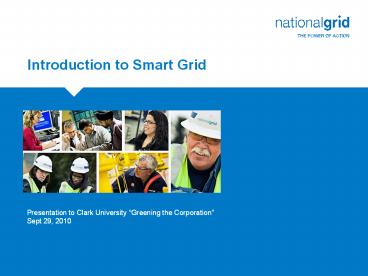Introduction to Smart Grid - PowerPoint PPT Presentation
1 / 13
Title:
Introduction to Smart Grid
Description:
... station CO2 transport and storage Hydro-electric power Heat Pumps Large scale CHP and biomass $$$ Gas production Onshore and offshore ... Transformer oil ... – PowerPoint PPT presentation
Number of Views:122
Avg rating:3.0/5.0
Title: Introduction to Smart Grid
1
Introduction to Smart Grid
- Presentation to Clark University Greening the
Corporation - Sept 29, 2010
2
National Gridan international electricity and
gas company
- 50 US, 50 UK
- 27,000 employees
- Distributes electricity to 3.3 million customers
- Provides natural gas to 3.5 million customers
- Services 1.1 million customers of Long Island
Power Authority (LIPA) - Currently owns over 4,000MW of generation
Gas
Electricity
3
National Grid An international electricity and
gas company
Gas Distribution - UK Transmission
Electricity and Gas - UK
Operates the UK gas distribution system
distributes gas on behalf of shippers and
suppliers to 11 million consumers but has 20m
meters
Owns the high-voltage electricity transmission
system in England and Wales and operates the
system across Britain. Also owns and operates the
high pressure gas transmission system in Britain.
4
Regulatory Environment
- Natural Monopoly
- Deregulation of Generation Assets
- Pipes and Wires Distribution
- Regulation by State PUCs
- Commodity Charge as Pass through
- Currently appears as an average KW price
5
Energy Market is evolving
Traditional Energy Market - supply driven
Todays Evolving Market - customer driven
Customers focus on economic and environmental
value, using a wider range of products and
services
Solar water heating
Micro CHP
Efficient Boilers
Heat Pumps
Large centralised generation
Domestic
Micro Biomass
Industrial and commercial
Micro wind
Smart metering
Small range of conventional technologies
Electricity flows to users, and surplus from
distributed generation flows back to grid
Nuclear power station
Gas production
Hydro-electric power
Coal/gas fired power station
Energy volume drives energy company revenue
Smart network technology rolled out
Natural Gas Hydrogen CO2 Biogas Heat
Static infrastructure
Intermittency management
Technology choice proliferates
Energy flows to users
Energy flows to users
Price and reliability are main determinants of
customer choice
Industrial and commercial
Onshore and offshore wind
Nuclear power station
CCS plant (coal/gas)
Hydro-electric power
Large scale CHP and biomass
Gas production
CO2 emission reduction and wider energy services
drives energy company revenue
CO2 transport and storage
6
Market Challenges
- Climate Change
- Reduce our emissions of greenhouse gases
- Reshape markets by aligning regulatory and public
policy incentives - Encourage energy efficiency
- Modernizing relationship with consumers
- Ageing Infrastructure and Skills
- Investment in Transmission and Distribution
- Enhance ability to handle renewable generation
- Support through regulatory framework
7
Technology has a key role Smarter grids and
smart metering
8
Smart technology means different things to
different people a common language and vision
are essential
- Smart Technology Definition
- Technology that provides advanced information,
automation and control capabilities to help us to
distribute, measure and use energy more
efficiently, reliably, safely and sustainably
all the way from the point of generation to
consumer appliances
What does it allow you to do?
What is Smart Technology?
- Meter that records interval data
- 2-way communications, remote configuration
- Informative display
- Meter Data Management System
- Automatic meter reading
- Enable customer choice and control
- Choice of tariffs e.g. time of use peak
shifting - Catalyst and validation of Energy Efficiency
programs - Remote configuration
Meter
- Sensors measuring devices
- Analytical programs e.g. pattern recognition
- Automatic switches controls
- Decision support tools graphical interfaces
- Enable Distributed generation
- Remotely detect, diagnose, predict and correct
network problems faults - Condition-based, preventative maintenance
- Automatic fault prevention, isolation
restoration
Grid
- Customer portal Home Area Network
- Automated thermostats, switches, plugs
appliances - Load controllers e.g. PHEV controller
- Automatically optimize selected home appliances
- Demand response programs
- Improve satisfaction levels
Home
9
The prime logic for Smart Grid? Customer and
Environmental Orientation.
The deployment of Smart Grid technologies will
enable the shift in customer behavior towards
Energy Efficiency, Energy Management and increase
Customer Service levels.
The one ratepayer approach to serving
residential and small business customers must
evolve, we will have to be more innovative to
satisfy customers going forward.
The trend to increased consumer choice and
control will be different for customers dependent
upon their circumstances and needs more
segmentation will occur.
With increasing volatility in energy prices, and
climate change becoming a more prominent public
concern, customer needs are changing. Customers
need the tools to play their part in the shift
towards a new energy future.
10
What will customers experience
Tomorrows energy - customer driven
Meter-centric home providing basic consumption
information, export (net) metering and, possibly,
appliance control
Appliance control/demand response
In-home display
Smart meter
Peak shaving and simple demand response, fault
identification restoration verification
Micro-generation
Network control centre
- More consumer involvement choice, Choice,
Control, Convenience. - More distributed generation
- Market drives solutions, closes customer
expectation gap - More integrated, holistic approach
11
National Grid Massachusetts and New York Proposals
12
Massachusetts Pilot Overview
- Response to MA Green Communities Act
- 15,000 electric only customers in Worcester
- Diverse customer base
- 57M cost Spine only
- 5 Substations, 17 Feeders
- Testing Critical Peak Price
- IHD Testing
13
How You Can Get Involved!
- Business Implications for Smart Grid
- National transformation effort
- We work with many business partners
- Community Based Marketing Plan
- Residential Customers
- Commercial Customers
- Partnering with Clark and WPI
- Volunteer Opportunities
- May link to Course Requirements































